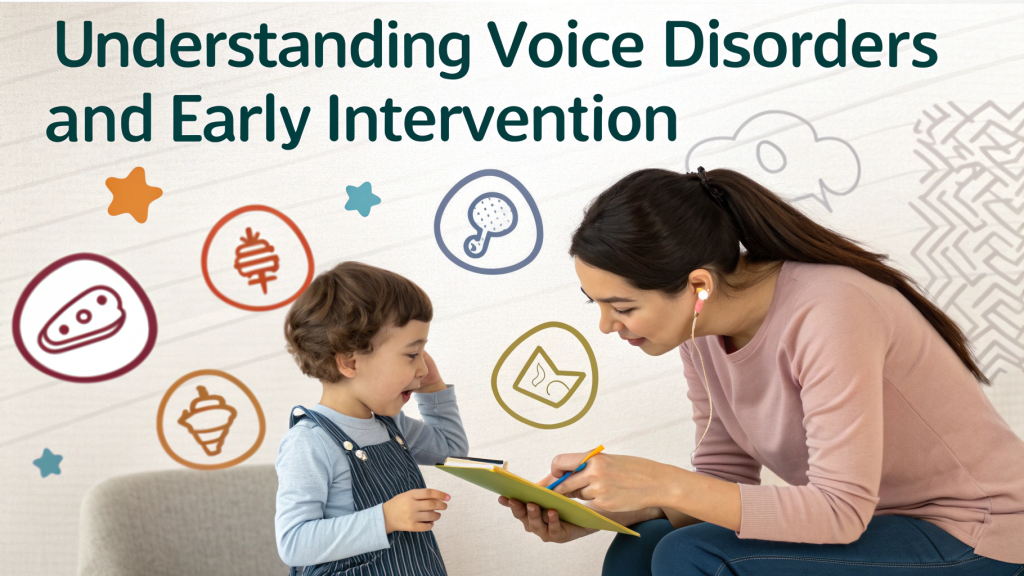Your voice is a vital component of your identity, self-expression, and professional life; it is more than just a tool for communication. When vocal problems occur, they can have a major effect on day-to-day activities and general quality of life. The early warning signals of voice disorders, their many origins, and how contemporary diagnostic technologies are transforming the field of voice disorder diagnosis and treatment are all covered in this extensive book.

Fundamentals of Voice Production
It’s important to comprehend how a healthy voice works before exploring voice issues. Numerous bodily systems interact intricately to make your voice. The vocal cords, which are two bands of elastic muscle tissue that vibrate to make sound as air passes between them, are housed in the larynx, also referred to as the voice box. Your voice’s distinct pitch, volume, and tone are produced by these vibrations as well as resonance in the mouth, throat, and nose.
A normal, healthy voice should:
- Keep the quality constant all day.
- Allow for stress-free pitch and loudness modulation.
- Make it possible to articulate words clearly
- Operate without pain or exhaustion.
- Encourage singing (within one’s natural range) and speaking.
Types of Voice Disorders
Based on their fundamental origins and traits, voice disorders can be divided into several major categories.
- Structural Voice Disorder- Physical anomalies such as nodules, polyps, cysts, or tumours in the larynx or vocal folds are associated with structural voice disorders.
Overuse, injuries, or other causes affecting the voice mechanism’s physical structure might cause these. - Neurogenic Voice Disorder– Nervous system issues that impact laryngeal control result in neurogenic voice abnormalities. Vocal tremor, vocal fold paralysis, and laryngeal dystonia (spasmodic dysphonia) are a few examples.
Involuntary spasms or abnormalities in vocal output may result from these diseases. - Functional Voice Disorder- When the larynx’s physical structure is normal but the vocal mechanism is employed incorrectly or inefficiently, functional voice problems result. Muscle strain, improper voice technique, or other behavioural issues may be the cause of this.
Voice therapy is frequently used as part of treatment to address these problems. - Psychogenic Disorder– It is thought that unresolved psychological concerns are the source of psychogenic voice disorders, which are uncommon. These conditions lack a known neurological or anatomical origin, therefore a vocal issue could be a metaphor for mental suffering.
Early Warning Signs: When to Pay Attention
Recognizing early signs of voice disorders is crucial for timely intervention and successful treatment. Here are the key symptoms to watch for:
Immediate Red Flags
Voice Quality Changes:
- Persistent hoarseness lasting more than two weeks
- Breathiness or weakness in voice production
- Unexpected changes in pitch range
- Voice breaks or crack during speech
Physical Sensations:
- Throat pain or discomfort while speaking
- Feeling of tightness or tension in the throat
- Chronic throat clearing or coughing
- Sensation of a lump in the throat
Traditional Diagnostic Methods
Laryngoscopy remains a foundational tool in voice disorder diagnosis. This procedure allows direct visualization of the vocal cords and surrounding structures. Modern versions include:
Flexible Laryngoscopy: A thin, flexible fiber-optic tube with a camera is passed through the nose to observe the larynx during natural speech and swallowing.
Videostroboscopy: This specialized technique uses strobe lighting to create a slow-motion effect of vocal cord vibration, enabling detailed analysis of vibratory patterns.
Advanced Technological Solutions
Acoustic Analysis Software:
Modern acoustic analysis tools can measure and quantify various aspects of voice production:
- Fundamental frequency (pitch)
- Intensity (loudness)
- Jitter and shimmer (voice stability measures)
- Harmonic-to-noise ratio
- Voice range profiles
These measurements provide objective data about voice function and can track treatment progress over time.
Artificial Intelligence in Voice Analysis:
AI-powered systems are revolutionizing voice disorder diagnosis through:
- Pattern recognition in voice samples
- Early detection of subtle voice changes
- Predictive analysis for disorder progression
- Automated screening tools for large populations
High-Speed Digital Imaging:
This technology captures thousands of frames per second of vocal cord movement, providing unprecedented detail about vibratory patterns and enabling detection of subtle abnormalities.
Vocal Hygiene Practices
Hydration:
- Drink plenty of water throughout the day
- Maintain proper humidity in living and working spaces
- Avoid excessive caffeine and alcohol
Voice Use:
- Practice appropriate vocal warm-ups before heavy voice use
- Take regular voice breaks during periods of extensive speaking
- Avoid shouting or speaking over loud noise
Environmental Factors:
- Minimize exposure to irritants like smoke and dust
- Use appropriate amplification when speaking to large groups
- Maintain good posture and breathing habits
Conclusion
Voice disorders represent a complex group of conditions that can significantly impact daily life and professional function. Thanks to advances in diagnostic technology and treatment approaches, these conditions can be identified earlier and managed more effectively than ever before. If you experience persistent voice changes or discomfort, don’t wait to seek professional evaluation—early intervention often leads to better outcomes.
Remember that your voice is a crucial tool for communication and self-expression. Understanding the signs of voice disorders and knowing when to seek help can make a significant difference in maintaining vocal health and preventing long-term problems. Whether you’re a professional voice user or someone concerned about voice changes, modern diagnostic tools and treatment approaches offer hope and solutions for maintaining optimal vocal function

